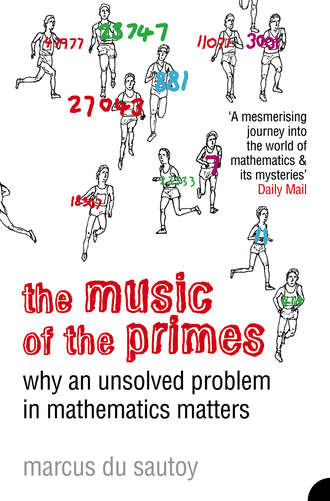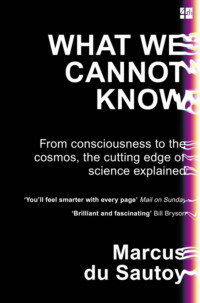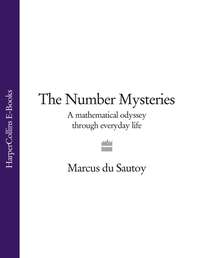
Полная версия
The Music of the Primes: Why an unsolved problem in mathematics matters

The Music of the
Primes Why an Unsolved Problem in Mathematics Matters
Marcus du Sautoy


Fourth Estate
An imprint of HarperCollinsPublishers Ltd. 1 London Bridge Street London SE1 9GF
www.harpercollins.co.uk
This edition published by Harper Perennial 2004
First published by Fourth Estate 2003
Copyright © Marcus du Sautoy 2003
PS section copyright © Josh Lacey 2004
PS™ is a trademark of HarperCollinsPublishers Ltd.
Marcus du Sautoy asserts the moral right to be identified as the author of this work
A catalogue record for this book is available from the British Library
All rights reserved under International and Pan-American Copyright Conventions. By payment of the required fees, you have been granted the nonexclusive, nontransferable right to access and read the text of this ebook on-screen. No part of this text may be reproduced, transmitted, downloaded, decompiled, reverse engineered, or stored in or introduced into any information storage and retrieval system, in any form or by any means, whether electronic or mechanical, now known or hereinafter invented, without the express written permission of HarperCollins e-books
HarperCollinsPublishers has made every reasonable effort to ensure that any picture content and written content in this ebook has been included or removed in accordance with the contractual and technological constraints in operation at the time of publication
Source ISBN: 9781841155807
Ebook Edition © MAY 2012 ISBN: 9780007375875
Version: 2017-05-03
Praise
From the reviews of The Music of the Primes:
‘A gripping, entertaining and thought-provoking book. Du Sautoy is certainly a brilliant storyteller and introduces us to some great personalities … Even if you don’t understand the maths, this is still a fascinating book. And if you do understand some of it, it will have you running for your calculator as you try to work out some of the riddles along the way’
Independent on Sunday
‘Delightfully entertaining … [Du Sautoy] has been successful in setting up a compelling dramatis personae of mathematicians, with every character vividly illuminated with anecdotes and felicitous comment’
Guardian
‘Du Sautoy … laces the ideas with history, anecdote and personalia – an entertaining mix that renders an austere subject palatable … Even those with a mathematical allergy can enjoy du Sautoy’s depictions of his cast of characters’
The Times
‘The subject is daunting, but du Sautoy writes with admirable clarity and verve’
Daily Mail
‘An engaging and accessible history of work on prime numbers and the Riemann hypothesis’
Economist
‘Entertaining … looks certain to be a great success’
Nature
Dedication
For the memory of
Yonathan du Sautoy October 21, 2000
Contents
Cover
Title Page
Copyright
Praise
Dedication
1 Who Wants To Be a Millionaire?
2 The Atoms of Arithmetic
3 Riemann’s Imaginary Mathematical Looking-Glass
4 The Riemann Hypothesis: From Random Primes to Orderly Zeros
5 The Mathematical Relay Race: Realising Riemann’s Revolution
6 Ramanujan, the Mathematical Mystic
7 Mathematical Exodus: From Göttingen to Princeton
8 Machines of the Mind
9 The Computer Age: From the Mind to the Desktop
10 Cracking Numbers and Codes
11 From Orderly Zeros to Quantum Chaos
12 The Missing Piece of the Jigsaw
Keep Reading
Acknowledgements
Further Reading
Illustration and Text Credits
Index
P.S.
About the Author
Portrait of Marcus du Sautoy
Snapshot
Top Ten Favourite Books
About the Book
A Critical Eye
Jerzy Grotowski
Read On
If You Loved This, You’ll Like …
Find Out More
About the Author
About the Publisher
CHAPTER ONE
Who Wants To Be a Millionaire?
‘Do we know what the sequence of numbers is? Okay, here, we can do it in our heads … fifty-nine, sixty-one, sixty-seven … seventy-one … Aren’t these all prime numbers?’ A little buzz of excitement circulated through the control room. Ellie’s own face momentarily revealed a flutter of something deeply felt, but this was quickly replaced by a sobriety, a fear of being carried away, an apprehension about appearing foolish, Unscientific. Carl Sagan, Contact
One hot and humid morning in August 1900, David Hilbert of the University of Göttingen addressed the International Congress of Mathematicians in a packed lecture hall at the Sorbonne, Paris. Already recognised as one of the greatest mathematicians of the age, Hilbert had prepared a daring lecture. He was going to talk about what was unknown rather than what had already been proved. This went against all the accepted conventions, and the audience could hear the nervousness in Hilbert’s voice as he began to lay out his vision for the future of mathematics. ‘Who of us would not be glad to lift the veil behind which the future lies hidden; to cast a glance at the next advances of our science and at the secrets of its development during future centuries?’ To herald the new century, Hilbert challenged the audience with a list of twenty-three problems that he believed should set the course for the mathematical explorers of the twentieth century.
The ensuing decades saw many of the problems answered, and those who discovered the solutions make up an illustrious band of mathematicians known as ‘the honours class’. It includes the likes of Kurt Gödel and Henri Poincaré, along with many other pioneers whose ideas have transformed the mathematical landscape. But there was one problem, the eighth on Hilbert’s list, which looked as if it would survive the century without a champion: the Riemann Hypothesis.
Of all the challenges that Hilbert had set, the eighth had a special place in his heart. There is a German myth about Frederick Barbarossa, a much-loved German emperor who died during the Third Crusade. A legend grew that he was still alive, asleep in a cavern in the Kyffhäuser Mountains. He would awake only when Germany needed him. Somebody allegedly asked Hilbert, ‘If you were to be revived like Barbarossa, after five hundred years, what would you do?’ His reply: ‘I would ask, “Has someone proved the Riemann Hypothesis?”’
As the twentieth century drew to a close, most mathematicians had resigned themselves to the fact that this jewel amongst all of Hilbert’s problems was not only likely to outlive the century, but might still be unanswered when Hilbert awoke from his five-hundred-year slumber. He had stunned the first International Congress of the twentieth century with his revolutionary lecture full of the unknown. However, there turned out to be a surprise in store for those mathematicians who were planning to attend the last Congress of the century.
On April 7, 1997, computer screens across the mathematical world flashed up some extraordinary news. Posted on the website of the International Congress of Mathematicians that was to be held the following year in Berlin was an announcement that the Holy Grail of mathematics had finally been claimed. The Riemann Hypothesis had been proved. It was news that would have a profound effect. The Riemann Hypothesis is a problem which is central to the whole of mathematics. As they read their email, mathematicians were thrilling to the prospect of understanding one of the greatest mathematical mysteries.
The announcement came in a letter from Professor Enrico Bombieri. One could not have asked for a better, more respected source. Bombieri is one of the guardians of the Riemann Hypothesis and is based at the prestigious Institute for Advanced Study in Princeton, once home to Einstein and Gödel. He is very softly spoken, but mathematicians always listen carefully to anything he has to say.
Bombieri grew up in Italy, where his prosperous family’s vineyards gave him a taste for the good things in life. He is fondly referred to by colleagues as ‘the Mathematical Aristocrat’. In his youth he always cut a dashing figure at conferences in Europe, often arriving in a fancy sports car. Indeed, he was quite happy to fuel a rumour that he’d once come sixth in a twenty-four-hour rally in Italy. His successes on the mathematical circuit were more concrete and led to an invitation in the 1970s to go to Princeton, where he has remained ever since. He has replaced his enthusiasm for rallying with a passion for painting, especially portraits.
But it is the creative art of mathematics, and in particular the challenge of the Riemann Hypothesis, that gives Bombieri the greatest buzz. The Riemann Hypothesis had been an obsession for Bombieri ever since he first read about it at the precocious age of fifteen. He had always been fascinated by properties of numbers as he browsed through the mathematics books his father, an economist, had collected in his extensive library. The Riemann Hypothesis, he discovered, was regarded as the deepest and most fundamental problem in number theory. His passion for the problem was further fuelled when his father offered to buy him a Ferrari if he ever solved it – a desperate attempt on his father’s part to stop Enrico driving his own model.
According to his email, Bombieri had been beaten to his prize. ‘There are fantastic developments to Alain Connes’s lecture at IAS last Wednesday,’ Bombieri began. Several years previously, the mathematical world had been set alight by the news that Alain Connes had turned his attention to trying to crack the Riemann Hypothesis. Connes is one of the revolutionaries of the subject, a benign Robespierre of mathematics to Bombieri’s Louis XVI. He is an extraordinarily charismatic figure whose fiery style is far from the image of the staid, awkward mathematician. He has the drive of a fanatic convinced of his world-view, and his lectures are mesmerising. Amongst his followers he has almost cult status. They will happily join him on the mathematical barricades to defend their hero against any counter-offensive mounted from the ancien régime’s entrenched positions.
Connes is based at France’s answer to the Institute in Princeton, the Institut des Hautes Études Scientifiques in Paris. Since his arrival there in 1979, he has created a completely new language for understanding geometry. He is not afraid to take the subject to the extremes of abstraction. Even the majority of the mathematical ranks who are usually at home with their subject’s highly conceptual approach to the world have balked at the abstract revolution Connes is proposing. Yet, as he has demonstrated to those who doubt the necessity for such stark theory, his new language for geometry holds many clues to the real world of quantum physics. If it has instilled terror in the hearts of the mathematical masses, then so be it.
Connes’s audacious belief that his new geometry could unmask not only the world of quantum physics but explain the Riemann Hypothesis – the greatest mystery about numbers – was met with surprise and even shock. It reflected his disregard for conventional boundaries that he dare venture into the heart of number theory and confront head-on the most difficult outstanding problem in mathematics. Since his arrival on the scene in the mid-nineties, there had been an expectancy in the air that if anyone had the resources to conquer this notoriously difficult problem, it was Alain Connes.
But it was not Connes who appeared to have found the last piece in the complex jigsaw. Bombieri went on to explain that a young physicist in the audience had seen ‘in a flash’ how to use his bizarre world of ‘super-symmetric fermionic—bosonic systems’ to attack the Riemann Hypothesis. Not many mathematicians knew quite what this cocktail of buzzwords meant, but Bombieri explained that it described ‘the physics corresponding to a near-absolute zero ensemble of a mixture of anyons and morons with opposite spins’. It still sounded rather obscure, but then this was after all the solution to the most difficult problem in the history of mathematics, so no one was expecting an easy solution. According to Bombieri, after six days of uninterrupted work and with the help of a new computer language called MISPAR, the young physicist had finally cracked mathematics’ toughest problem.
Bombieri concluded his email with the words, ‘Wow! Please give this the highest diffusion.’ Although it was extraordinary that a young physicist had ended up proving the Riemann Hypothesis, it came as no great surprise. Much of mathematics had found itself entangled with physics over the past few decades. Despite being a problem with its heart in the theory of numbers, the Riemann Hypothesis had for some years been showing unexpected resonances with problems in particle physics.
Mathematicians were changing their travel plans to fly in to Princeton to share the moment. Memories were still fresh with the excitement of a few years earlier when an English mathematician, Andrew Wiles, had announced a proof of Fermat’s Last Theorem in a lecture delivered in Cambridge in June 1993. Wiles had proved that Fermat had been right in his claim that the equation xn + yn = zn has no solutions when n is bigger than 2. As Wiles laid down his chalk at the end of the lecture, the champagne bottles started popping and the cameras began flashing.
Mathematicians knew, however, that proving the Riemann Hypothesis would be of far greater significance for the future of mathematics than knowing that Fermat’s equation has no solutions. As Bombieri had discovered at the tender age of fifteen, the Riemann Hypothesis seeks to understand the most fundamental objects in mathematics – prime numbers.
Prime numbers are the very atoms of arithmetic. The primes are those indivisible numbers that cannot be written as two smaller numbers multiplied together. The numbers 13 and 17 are prime, whilst 15 is not since it can be written as 3 times 5. The primes are the jewels studded throughout the vast expanse of the infinite universe of numbers that mathematicians have explored down the centuries. For mathematicians they instil a sense of wonder: 2, 3, 5, 7, 11, 13, 17, 19, 23, … – timeless numbers that exist in some world independent of our physical reality. They are Nature’s gift to the mathematician.
Their importance to mathematics comes from their power to build all other numbers. Every number that is not a prime can be constructed by multiplying together these prime building blocks. Every molecule in the physical world can be built out of atoms in the periodic table of chemical elements. A list of the primes is the mathematician’s own periodic table. The prime numbers 2, 3 and 5 are the hydrogen, helium and lithium in the mathematician’s laboratory. Mastering these building blocks offers the mathematician the hope of discovering new ways of charting a course through the vast complexities of the mathematical world.
Yet despite their apparent simplicity and fundamental character, prime numbers remain the most mysterious objects studied by mathematicians. In a subject dedicated to finding patterns and order, the primes offer the ultimate challenge. Look through a list of prime numbers, and you’ll find that it’s impossible to predict when the next prime will appear. The list seems chaotic, random, and offers no clues as to how to determine the next number. The list of primes is the heartbeat of mathematics, but it is a pulse wired by a powerful caffeine cocktail:

The prime numbers up to 100 – mathematics’ irregular heartbeat.
Can you find a formula that generates the numbers in this list, some magic rule that will tell you what the 100th prime number is? This question has been plaguing mathematical minds down the ages. Despite over two thousand years of endeavour, prime numbers seem to defy attempts to fit them into a straightforward pattern. Generations have sat listening to the rhythm of the prime-number drum as it beats out its sequence of numbers: two beats, followed by three beats, five, seven, eleven. As the beat goes on, it becomes easy to believe that random white noise, without any inner logic, is responsible. At the centre of mathematics, the pursuit of order, mathematicians could only hear the sound of chaos.
Mathematicians can’t bear to admit that there might not be an explanation for the way Nature has picked the primes. If there were no structure to mathematics, no beautiful simplicity, it would not be worth studying. Listening to white noise has never caught on as an enjoyable pastime. As the French mathematician Henri Poincaré wrote, ‘The scientist does not study Nature because it is useful; he studies it because he delights in it, and he delights in it because it is beautiful. If Nature were not beautiful, it would not be worth knowing, and if Nature were not worth knowing, life would not be worth living.’
One might hope that the prime-number heartbeat settles down after a jumpy start. Not so – things just seem to get worse the higher you count. Here are the primes amongst the 100 numbers either side of 10,000,000. First, those below 10,000,000:
9,999,901 9,999,907, 9,999,929, 9,999,931, 9,999,937, 9,999,943, 9,999,971, 9,999,973, 9,999,991
But look now at how few there are in the 100 numbers above 10,000,000:
10,000,019, 10,000,079.
It is hard to guess at a formula that could generate this kind of pattern. In fact, this procession of primes resembles a random succession of numbers much more than it does a nice orderly pattern. Just as knowing the first 99 tosses of a coin won’t help you much in guessing the result of the 100th toss, so do the primes seem to defy prediction.
Prime numbers present mathematicians with one of the strangest tensions in their subject. On the one hand a number is either prime or it isn’t. No flip of a coin will suddenly make a number divisible by some smaller number. Yet there is no denying that the list of primes looks like a randomly chosen sequence of numbers. Physicists have grown used to the idea that a quantum die decides the fate of the universe, randomly choosing at each throw where scientists will find matter. But it is something of an embarrassment to have to admit that these fundamental numbers on which mathematics is based appear to have been laid out by Nature flipping a coin, deciding at each toss the fate of each number. Randomness and chaos are anathema to the mathematician.
Despite their randomness, prime numbers – more than any other part of our mathematical heritage – have a timeless, universal character. Prime numbers would be there regardless of whether we had evolved sufficiently to recognise them. As the Cambridge mathematician G.H. Hardy said in his famous book A Mathematician’s Apology, ‘317 is a prime not because we think so, or because our minds are shaped in one way or another, but because it is so, because mathematical reality is built that way.’
Some philosophers might take issue with such a Platonist view of the world – this belief in an absolute and eternal reality beyond human existence – but to my mind that is what makes them philosophers and not mathematicians. There is a fascinating dialogue between Alain Connes, the mathematician who featured in Bombieri’s email, and the neurobiologist Jean-Pierre Changeux in Conversations on Mind, Matter and Mathematics. The tension in this book is palpable as the mathematician argues for the existence of mathematics outside the mind, and the neurologist is determined to refute any such idea: ‘Why wouldn’t we see “π = 3.1416” written in gold letters in the sky or “6.02 × 1023” appear in the reflections of a crystal ball?’ Changeux declares his frustration at Connes’s insistence that ‘there exists, independently of the human mind, a raw and immutable mathematical reality’ and at the heart of that world we find the unchanging list of primes. Mathematics, Connes declares, ‘is unquestionably the only universal language’. One can imagine a different chemistry or biology on the other side of the universe, but prime numbers will remain prime whichever galaxy you are counting in.
In Carl Sagan’s classic novel Contact, aliens use prime numbers to contact life on earth. Ellie Arroway, the book’s heroine, has been working at SETI, the Search for Extraterrestrial Intelligence, listening to the crackle of the cosmos. One night, as the radio telescopes are turned towards Vega, they suddenly pick up strange pulses through the background noise. It takes Ellie no time to recognise the drumbeat in this radio signal. Two pulses are followed by a pause, then three pulses, five, seven, eleven, and so on through all the prime numbers up to 907. Then it starts all over again.
This cosmic drum was playing a music that earthlings couldn’t fail to recognise. Ellie is convinced that only intelligent life could generate this beat: ‘It’s hard to imagine some radiating plasma sending out a regular set of mathematical signals like this. The prime numbers are there to attract our attention.’ Had the alien culture transmitted the previous ten years of alien winning lottery numbers, Ellie couldn’t have distinguished them from the background noise. Even though the list of primes looks as random a list as the lottery winnings, its universal constancy has determined the choice of each number in this alien broadcast. It is this structure that Ellie recognises as the sign of intelligent life.
Communicating using prime numbers is not just science fiction. Oliver Sacks in his book The Man Who Mistook His Wife for a Hat documents twenty-six-year-old twin brothers, John and Michael, whose deepest form of communication was to swap six-digit prime numbers. Sacks tells of when he first discovered them secretly exchanging numbers in the corner of a room: ‘they looked, at first, like two connoisseurs wine-tasting, sharing rare tastes, rare appreciations’. At first, Sacks can’t figure out what the twins are up to. But as soon as he cracks their code, he memorises some eight-digit primes which he drops surreptitiously into the conversation at their next meeting. The twins’ surprise is followed by deep concentration which turns to jubilation as they recognise another prime number. Whilst Sacks had resorted to prime number tables to find his primes, how the twins were generating their primes is a tantalising puzzle. Could it be that these autistic-savants were in possession of some secret formula that generations of mathematicians had missed?
The story of the twins is a favourite of Bombieri’s.
It is hard for me to hear this story without feeling awe and astonishment at the workings of the brain. But I wonder: Do my non-mathematical friends have the same response? Do they have any inkling how bizarre, how prodigious and even other-worldly was the singular talent the twins so naturally enjoyed? Are they aware that mathematicians have been struggling for centuries to come up with a way to do what John and Michael did spontaneously: to generate and recognize prime numbers?





